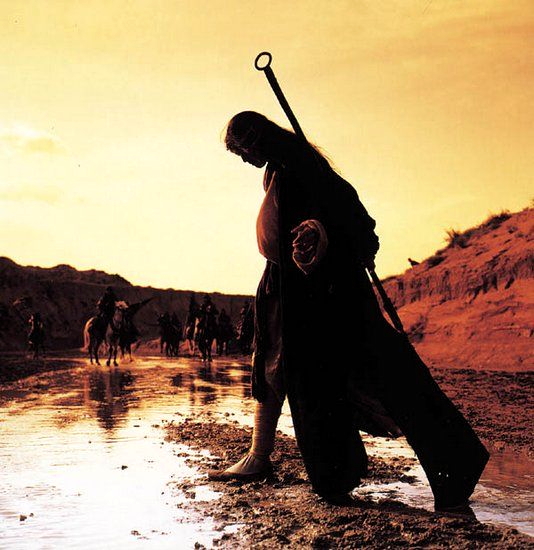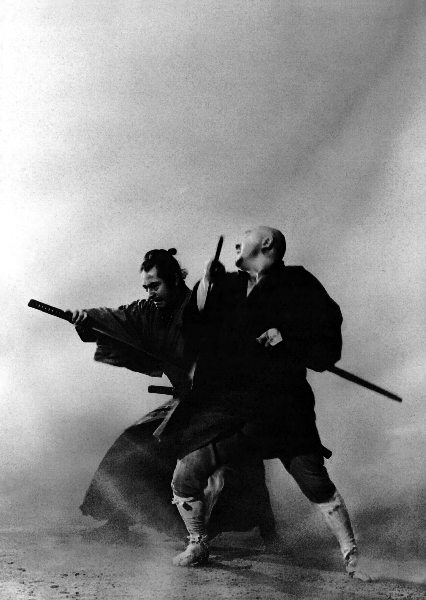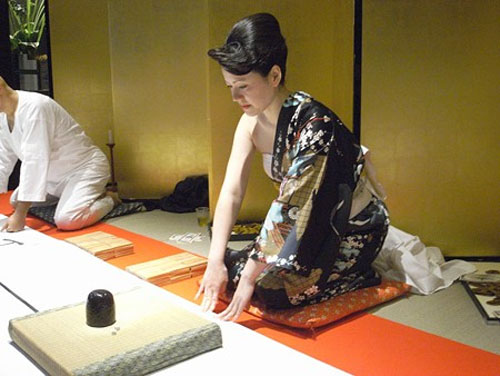
DIVIDING UP THE SAMPLE POWERS LIST
When I sent Steve Long Chapter Three for HERO System Martial Arts, I sent him this breakdown of how I decided which powers went under which header:
Realistic: Things people can really do and/or learn (this includes Battlefield Punches and Bruce Lee's One-Inch Punch).
Cinematic: Things I expect to see in the movies of Bruce Lee, Jackie Chan, Toshiro Mifune, Steven Seagal (and so on), or comics like Usagi Yojimbo.
Wuxia: Things I'd expect to see (or have seen) in the films of Jet Li, Tsui Hark, Andy Lau, Stephen Chow, and so on.
Video Game: Powers that have, well, a "video game" feel to them.
Anime: Things I'd expect to see in a lot of top-end wuxia movies (such as The Storm Riders or Zu Warriors), or in many fighting anime (such as Bleach or Dragon Ball Z), or in any anime based off of a video game, or in totally over the top fighting-based comics or manga (such as Weapons of the Gods).
MARTIAL ARTS SUBGENRES
In Asia, martial arts films come in many flavors—there are historical epics, period pieces, biopics, films about real (and fictional) martial arts heroes, and full-blown fantasy films. Some use realistic martial arts (such as bio pics and Jackie Chan's Police Story films) while many of the others rapidly enter into “wire fu” territory. This latter element is also an important distinction of Asian martial arts movies. Some people dislike (even hate) wire-based martial arts films due to people flying around in the air and the like. I think it's important for people to look at these sorts of films as fantasy (or superhero) films. Western fantasy films have dragons, orcs, bare-chested barbarian swordsman, and sorceresses in gold and silk bikinis. Eastern fantasy films have super-powered martial artists who can fly, walk on water, cut trees in two with their swords, and fire arrows with the stopping power of a .50 sniper rifle. In addition, many video fighting games verge on fantasy and/or the realm of super-heroes, right down to the colorful costumes and signature attacks.
It's also worthwhile to point out that many martial arts films fill Western genre niches quite nicely. There are war movies (often combined with historical epics), love stories (a subplot in many films), Westerns (Seven Samurai, Yojimbo, and Seven Swords are basically Westerns), Pulp-era action (Fist of Legend and Ip Man take place in the 30s), detective stories (a lot of the Zatoichi movies involve Zatoichi uncovering some nefarious plot or hidden crime), and so on. And these days, with CGI technology, you are getting more adaptations of Chinese comics (and Japanese manga) in live-action form (examples include Dragon Tiger Gate, Shinobi, and The Stormriders).
There’s also a new class of martial arts movie as well, which is the martial arts superhero film, such as Arahan, Vampire Cop Ricky, the new Green Hornet film, and others. I've seen clips (sadly no titles, just the film clips) of fully-costumed individuals slugging it out in what looks like the streets of Hong Kong or Tokyo (or Seoul), showing that Asian cinema is willing to co-op anything (much like Hollywood will gladly steal from Hong Kong).
Finally, there’s the trend in adapting video games to the screen. Most have been pretty horrible (Street Fighter, Dead or Alive, Legend of Chun Li), although there seem to be a few coming that might be good. So far, the best of these is Street Fighter II: The Animated Movie. In this movie, the characters are super heroes in all but name, complete with distinctive costumes, powers, techniques, and styles. They even have an evil organization and master villain to fight against (M. Bison and Shadowlaw).
To sum up, the martial arts genre, at least cinematically, can encompass just about any gaming genre or sub-genre you could even want to run, from the everyday to as wild as you can possibly imagine.
MARTIAL ARTS TRICKS AND STUNTS
Watching martial arts films, you see a lot of combat tricks and stunts in the course of one-on-one duels. These include characters knocking swords being drawn back into their sheaths, or two samurai go to draw and one draws his foe's sword first! Also, combining a Fast Draw with a Block of your foe's draw and then cutting your foe with your blocking sword.
More general power stunts include tossing a disarmed foe's sword back into his sheath, splitting arrows with your own arrow, and destroying a foe's sword by wrapping it around your own.
THE TROPES OF DYNAMIC COMBAT
Some thoughts on common tropes seen in martial arts cinema.
1) Attacks so powerful even blocking them is painful. This showed up in Wild Cards—Carnifex and Moonchild fight and Moonchild ends up with aching and bruised arms and legs. She'd blocked all of Carnifex’s strikes, but was still hurting. This wasn’t a case of “your Block failed” as Moonchild didn't take the full force of Carnifex’s blows, it was just he hit so hard, that after a while it became painful to keep up an active defense. A related version is where a character blocks an attack, but is still slid along the ground (or knocked over, so some such). No damage is taken, but you do get tossed around.
2) Attacks so powerful they shatter blocking weapons and still do damage to the target.
3) Hitting your foe up into the air and then hitting him again while airborne. In some cases, you hit the guy, move to where he's going to land, then hit him again, sending him flying across the landscape.
4) Throwing a weapon (usually a spear of staff) at a foe then catching said weapon on the rebound. In many cases, the weapon hits lengthwise (i.e. the staff section of the spear). A related version of this is letting go of your weapon while fighting, having it spin around your foe (or his weapon) and then grabbing it a moment later. While your weapon is doing this, you hit your opponent with a punch or kick.
5) Fighting on variable surfaces. For example, in Hero two guys fight in a courtyard, but at various points they are "standing" on various vertical surfaces (such as pillars or the sides of a railing) and in one case are even upside down. None of this affects their fighting skill in the slightest.
6) Collateral damage. Strikes that miss, be they sword blows, punches, kicks, arrows, and what not, do serious damage to the surroundings. In some cases, landing after Leaping (or Leaping to being with) damages the ground. Also, characters break walls simply by getting knocked into them (doing more damage than any Knockback would normally allow).
7) Waiting until a leaping or flying character is just about to hit you and hitting him first. In some cases, you hit the incoming fist or foot, blocking the attack and doing damage to the attacker. This is often a case of a Damage Shield and/or Trigger.

THE TROPES OF DYNAMIC COMBAT—LOCATION AND MOVEMENT
Martial arts movies seem to enjoy staging their fights in interesting locations. Examples can range from open fields to a forest of vertical posts (which are on fire!) and anything in between. Jackie Chan loves setting his fights in locations that let him show off his acrobatic skills, while many wuxia films have a lot of tall objects around for characters to leap and fly to.
In both martial arts cinema and the real world any fight will tend to range over the local area. A character who Blocks and Dodges will tend to move while doing so, often moving back and away from the attacker. You also see this in sword fights a lot—strike-block-strike-block-separate-pace-pace-pace-strike-rinse-repeat. The pacing is often the fighters circling each other looking for an opening. I'm not sure how to simulate that in HERO System, since levels and DCV are Persistent... unless you want to create some sort of “dropping of the guard” effect, where one character's DCV drops (or something akin to that) giving the other character an opening to attack.
In cinematic hand-to-hand fights you see a lot of movement, with characters often jumping around, leaping on to things, being knocked back and getting up, and sometimes using the scenery to help launch an attack. Granted, this is easier to simulate I think, especially with the new meter scale, as any throw will move the character a meter or two, take downs might do the same, and rolls to recover your feet after a throw should require the character to move a few meters to complete it. But still, when envisioning your martial arts battle, GMs should encourage movement (by giving OCV bonuses and using different Hit Location charts depending on angle of attack).
THE TROPES OF DYNAMIC COMBAT—COLLATERAL DAMAGE
A final note—having just watched some Korean "wuxia" films (and man, the Koreans are making some awesome martial arts films), I've seen a lot of tearing up the scenery in the course of a fight. This is especially true in weapons-based combats. One effect is that if a character Dodges a blow, the GM could rule that anything near the character is hit instead (since a sword swing does take up space). Since anything but Real World Martial Arts should ignore the Real Weapon Limitation, the GM could then declare that anything nearby that's breakable and/or interesting is hit and destroyed instead. So in the case of the film Frozen Flower, the characters hack up the walls and doors, split a table, smash vases, and generally wreck the place, since every miss almost invariably hits something in the set and not the actors. At the same time, the characters also chop through things while swinging at each other. In this case I think the GM, in the interest of drama and the Rule of Cool factor, can allow PCs to hack right through stuff on the way to hitting their real target. I presume those who want to do the math could invoke some sort of "Casual DCs" rule, where if 1/2 your normal DCs are more than the DEF and BODY of something, you can blow right through it. Personally, as along as the object isn't something like a stone pillar or the like, I'd say "go for it." Of course, in some Anime Martial Arts setting, characters might just be able to "Casual DC" a stone pillar in two....
A Bonus Cinematic Martial Arts Power
DETECT DIE ROLL
Target: Self
Duration: Persistent
Range: Self
END Cost: 0
Game Information: Detect Die Roll (INT Roll) (Hearing Group). Total cost: 3 points.
Options:
1) Sharper Ears: Increase to INT Roll +2. Total cost: 5 points.
2) Even Sharper Ears: Increase to INT Roll +4. Total cost: 7 points.

Return to HERO System Source Material